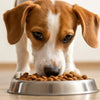Should Dogs Eat Kibble or Wet Food? A Comprehensive Guide for Pet Owners
- Houndsy
Table of Contents
- Introduction
- The Basics: What Are Kibble and Wet Food?
- Nutritional Considerations: What Do Dogs Need?
- Mixing It Up: Combining Kibble and Wet Food
- The Role of Feeding Tools: Elevating the Experience with Houndsy
- Conclusion
Introduction
Did you know that nearly 80% of dog owners report confusion when it comes to selecting the right food for their furry friends? With so many options available, including dry kibble, canned food, and everything in between, it’s no wonder many of us find ourselves asking, "Should dogs eat kibble or wet food?" This decision is crucial not just for our pets' health, but also for their happiness and overall well-being.
As pet owners, we want what’s best for our dogs, but the sheer volume of choices can be overwhelming. The debate between kibble and wet food often boils down to personal preferences, nutritional needs, and specific health considerations. In this blog post, we will explore the benefits and drawbacks of both kibble and wet food, helping you make an informed decision about your dog’s diet.
By the end of this article, you will have a clearer understanding of which option may be best suited for your pet, as well as practical tips for feeding routines and product recommendations, including how the Houndsy Kibble Dispenser can enhance your feeding experience. Let’s dive into the details!
The Basics: What Are Kibble and Wet Food?
Before we can compare kibble and wet food, it’s essential to understand what each type of food consists of and how they are processed.
Kibble: The Dry Option
Kibble, also known as dry dog food, is the most common type of dog food on the market. It is typically made from a mixture of meat, grains, and vegetables that are cooked, extruded, and then dried. The drying process reduces moisture content significantly, usually to around 10%. This low moisture content contributes to its long shelf life and ease of storage.
Advantages of Kibble
- Convenience: Kibble is easy to measure and serve. It can be left out for grazing, and it won’t spoil if not eaten immediately.
- Dental Health: The texture of kibble can help reduce tartar buildup as dogs chew their food, promoting better dental hygiene.
- Cost-Effective: Generally, kibble tends to be less expensive than wet food on a per-calorie basis, making it a more budget-friendly option for many pet owners.
Disadvantages of Kibble
- Lower Moisture Content: The lack of moisture in kibble means dogs may not get enough hydration, especially if they don't drink enough water.
- Palatability: Some dogs may find kibble less appealing than wet food, which could lead to decreased appetite or picky eating habits.
- Potential for Overeating: Kibble can be less satisfying for some dogs, leading them to eat more without feeling full.
Wet Food: The Moist Alternative
Wet food, often referred to as canned food, has a significantly higher moisture content—typically between 70% to 80%. This makes it a popular choice for pet owners looking to provide their dogs with hydration through their meals.
Advantages of Wet Food
- Hydration: The high moisture content helps keep dogs hydrated, which is particularly beneficial for those who don’t drink enough water.
- Flavor and Aroma: Wet food is often more aromatic and flavorful, making it appealing for picky eaters or dogs recovering from illness.
- Easier to Chew: For dogs with dental issues or those who are older, wet food can be easier to chew and digest.
Disadvantages of Wet Food
- Cost: Wet food is usually more expensive than kibble, particularly when considering the cost per calorie.
- Storage and Spoilage: Once opened, wet food needs to be refrigerated and used within a few days to prevent spoilage.
- Limited Dental Benefits: Wet food does not offer the same dental benefits as kibble, which can lead to potential dental issues over time.
Nutritional Considerations: What Do Dogs Need?
When deciding between kibble and wet food, it’s essential to consider your dog’s nutritional needs. Dogs require a balanced diet that includes proteins, fats, carbohydrates, vitamins, and minerals. Both kibble and wet food can provide these nutrients, but the specific formulation can vary significantly between brands and types.
Protein Quality and Source
The quality and source of protein in dog food are critical. Look for high-quality animal proteins (like chicken, beef, or fish) as the primary ingredient in either kibble or wet food. It's worth noting that both types of food can meet your dog's protein needs, but the moisture content in wet food can dilute the protein concentration.
Ingredients and Additives
When choosing dog food, always read the ingredient list. Look for foods that contain whole ingredients and avoid those with fillers or artificial additives. Some wet foods may contain added preservatives to maintain freshness, while premium kibble brands often include probiotics for digestive health.
Mixing It Up: Combining Kibble and Wet Food
For many pet owners, the best solution may not be an either/or scenario. Mixing kibble and wet food can provide the benefits of both while addressing the drawbacks. Here’s how mixing can be advantageous:
- Enhanced Palatability: Combining the two can make meals more appealing to dogs, encouraging them to eat.
- Balanced Hydration: The moisture from wet food can boost hydration while still providing the dental benefits of kibble.
- Cost Savings: Using wet food as a topper for kibble can reduce the amount of kibble needed, helping to save money over time.
Tips for Mixing
- Consult Your Veterinarian: Always discuss dietary changes with your vet to ensure that you are meeting your dog's specific nutritional needs.
- Monitor Portions: Be mindful of the total calorie intake to avoid overfeeding, especially if mixing foods. Adjust portions accordingly.
- Experiment with Textures: Dogs may respond differently to various combinations, so try different ratios of kibble to wet food to find what your dog enjoys most.
The Role of Feeding Tools: Elevating the Experience with Houndsy
At Houndsy, we understand that the feeding experience is not just about nutrition; it's also about creating a beautiful and functional space for your beloved pet. Our flagship product, the Houndsy Kibble Dispenser, exemplifies our commitment to combining innovative design with everyday convenience.
Key Features of the Houndsy Kibble Dispenser
- Perfect Portion Control: Our dispenser allows for precise portions, ensuring your pet gets the right amount of food every time.
- Ergonomic Design: The convenient crank mechanism at standing height eliminates the need for bending, making feeding easier for both pet owners and their furry friends.
- Stylish Design: With its mid-century modern aesthetic, the Houndsy Kibble Dispenser adds a touch of elegance to your home decor while serving a functional purpose.
By integrating the Houndsy Kibble Dispenser into your feeding routine, you can simplify the process while enhancing the overall experience for both you and your dog.
Conclusion
Deciding whether your dog should eat kibble or wet food ultimately comes down to personal preference, specific health needs, and the overall lifestyle of your pet. Both options have their unique benefits and drawbacks, and many pet owners find success in mixing the two for a balanced diet.
At Houndsy, our mission is to simplify and elevate the dog-feeding experience, ensuring that mealtime is not just nutritious but also enjoyable. We encourage you to explore our Houndsy Kibble Dispenser to enhance your feeding routine.
As you reflect on your dog’s diet, consider their individual needs and preferences. Whether you choose kibble, wet food, or a combination of both, what matters most is providing them with a balanced, nutritious diet that keeps them happy and healthy.
FAQ
1. Can I feed my dog only kibble or only wet food?
Yes, dogs can thrive on either kibble or wet food alone, as long as the food is nutritionally balanced. However, mixing both can provide variety and additional benefits.
2. How do I transition my dog from one type of food to another?
To transition your dog, gradually mix the new food with the old food over the course of several days, increasing the new food's proportion each day. This helps prevent digestive upset.
3. Are there any breeds that prefer one type of food over the other?
Some breeds may have specific preferences, but it ultimately varies from dog to dog. Picky eaters may prefer wet food, while others may enjoy the crunch of kibble.
4. How much food should I feed my dog?
Feeding amounts depend on your dog's size, age, activity level, and specific health needs. Always consult your veterinarian for personalized recommendations.
5. How can I ensure my dog stays hydrated?
If you feed kibble, make sure your dog has access to fresh water at all times. If you choose wet food, the moisture content will help with hydration, but it’s still important to provide water.












